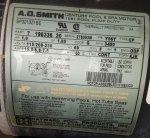Hey all its been a while since I've been on the site.
I need help with ordering and new pump motor along with anything else I might need to do the replacement correctly. I cant seem to find the exact model number for replacement so I am hoping for some guidance with that. I have attached a pic of the tag on my current motor. TIA
I need help with ordering and new pump motor along with anything else I might need to do the replacement correctly. I cant seem to find the exact model number for replacement so I am hoping for some guidance with that. I have attached a pic of the tag on my current motor. TIA


